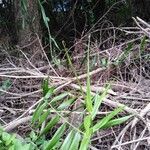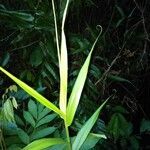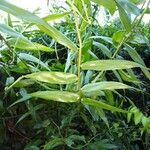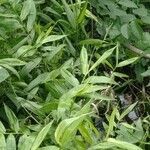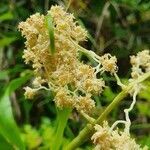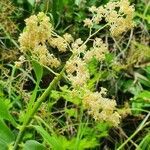Perennial climber to 5 m. high.. Leaf-sheaths cylindric, entire, longitudinally ribbed, subtruncate, with a chartaceous rim on the margin opposed to the blade; leaf-blade broadly lanceolate or linear, rounded below and abruptly contracted into a subpetiolar base 3–10 mm. long, attenuate above, with a cirriform involute tip, 14–18 cm. long, 15–20 mm. wide, entire at the margins, glabrous.. Inflorescence a terminal panicle, with a stout bilaterally compressed rhachis and branches; flowers in subsessile very short subglobose spikes; rhachis and branches glabrous; bracts ovate, 1–1.25 mm. long, membranous.. Perianth-segments 6, rarely 8, ovate, 2–3 mm. long in 2 subequal whorls, those of the outer whorl slightly smaller, white or greenish.. Stamens exserted, equalling the perianth-segments in number.. Ovary globose, with a terminal style and 3 linear stigmas.. Drupe spherical, 5–6 mm. in diameter, red.
An evergreen vine. It grows to 10 m tall. It climbs high into trees by modified tendrils on the tips of leaves. The stem is vigorous and branching. The stems are woody and 1-3 cm thick. The stem is covered with overlapping leaf sheaths. The leaves are narrow and sword shaped. They taper at both ends and the tips curve backwards forming tendrils. Leaves are 8-30 cm long and 0.7-2 cm wide. They are bright green and have parallel veins. They do not have a leaf stalk but clasp the stem. The flowers are very small and occur in sprays at the ends of branches. They are white. The fruit are berries which are small and fleshy and red when ripe. They are 0.3-0.5 cm across. The fruit are edible.
Plants perennial. Leaf sheath 2--7 cm; pseudopetiole 3--8 mm, abaxially flattened; leaf blade lanceolate to linear, 7--25 × 0.5--2 cm, base abruptly contracted, rounded, or slightly cordate. Panicles erect, irregularly branched, dense; bracts short, broad. Flowers small; tepals white, ovate to broadly so, 2--3 mm, thinly membranous. Stamens exserted. Ovary narrow. Drupes reddish when mature, globose, 4--6 mm in diam., smooth. Seeds 1(or 2). Fl. Apr--Jul, fr. Sep--Nov.
